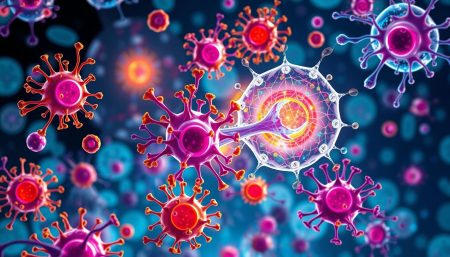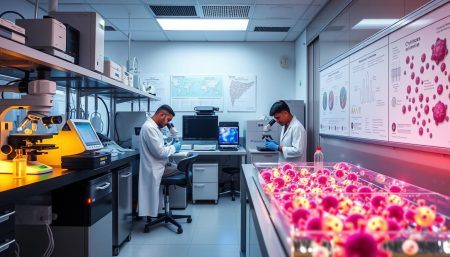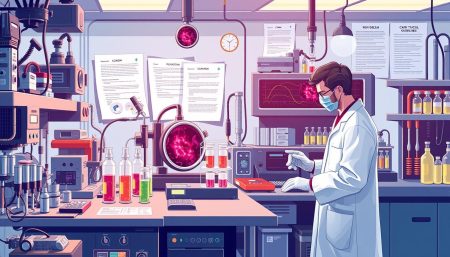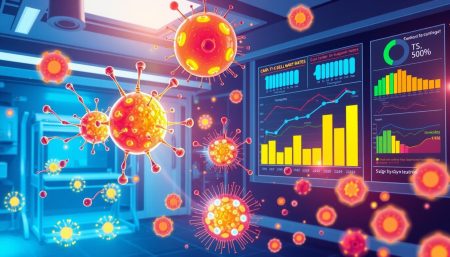Cancer is a complex disease that affects millions of people worldwide. This guide aims to shed light on the multifaceted nature of malignancies. We’ll explore their origins, warning signs, and various treatment approaches.
From the basics of oncology to cutting-edge therapies, we’ll explore the journey of cancer patients. We’ll also look at the advancements in medical science that bring hope to many.
As we dive into the world of tumors and their impact on human health, we’ll cover essential topics. These include risk factors, screening methods, and innovative treatments.
This guide is designed to provide valuable information for patients, caregivers, and anyone seeking to understand cancer. It aims to cover the challenges and progress in cancer research and care.
What is Cancer: Defining the Disease and Its Impact
Cancer is a complex disease that affects millions globally. It happens when cells grow out of control, forming tumors. These tumors can spread throughout the body. Knowing how cancer works is key to stopping it and treating it.
The Biology of Cancer Cells
Cancer cells are different from normal cells. They grow fast, ignore growth stops, and don’t die when they should. These cells can invade nearby tissues and spread to other parts of the body, a process called metastasis.
How Cancer Develops and Spreads
Cancer starts with genetic mutations that let cells grow without control. As these cells grow, they form tumors. Some tumors stay in one place, while others spread to other parts of the body through blood or lymph vessels.
Impact on Global Health
Cancer has a big impact on global health. It’s a top cause of death worldwide, affecting people of all ages and backgrounds. The field of oncology is always improving, finding new ways to fight this disease.
| Cancer Type | Estimated New Cases (2021) | Estimated Deaths (2021) |
|---|---|---|
| Breast Cancer | 284,200 | 44,130 |
| Lung Cancer | 235,760 | 131,880 |
| Colorectal Cancer | 149,500 | 52,980 |
| Prostate Cancer | 248,530 | 34,130 |
Early Warning Signs and Symptoms of Cancer
Spotting cancer symptoms early can save lives. Not every symptom means cancer, but noticing body changes is key. This helps with early cancer screening and detection. Let’s look at some common signs that might mean you should see a doctor.

Unexplained weight loss is a common cancer sign. Losing 10 pounds without trying is a reason to visit your doctor. Feeling tired all the time, even after resting, is also a concern. Fever or night sweats could point to blood cancers.
Skin changes are another warning sign. Watch for new moles, changes in old ones, or sores that won’t heal. These could be signs of skin cancer or other tumors. Persistent pain in one area, getting worse, is not something to ignore.
- Unusual bleeding or bruising
- Changes in bowel or bladder habits
- Persistent cough or hoarseness
- Difficulty swallowing
- Lumps or thickening under the skin
Keep in mind, these symptoms don’t always mean cancer. Many can be from less serious issues. The important thing is to listen to your body and get medical help if changes last. Regular cancer screening tests are also key, even without symptoms.
Common Types of Cancer and Their Characteristics
Cancer has many forms, each with its own features. Let’s look at the most common types of carcinoma and malignancy that affect millions globally.
Breast Cancer
Breast cancer begins in the breast tissue. It’s the leading cancer in women. Look out for lumps or changes in breast shape. Regular mammograms can find it early.
Lung Cancer
Smoking causes most lung cancer. Symptoms like a chronic cough or chest pain show up late. Early detection is hard. But, low-dose CT scans can spot it early in high-risk groups.
Colorectal Cancer
This cancer affects the colon or rectum. It starts as small growths called polyps. Screening tests like colonoscopies can find and remove these polyps before they become cancerous.
Prostate Cancer
Prostate cancer is common in older men. It grows slowly. Many men with prostate cancer don’t need treatment. Regular check-ups and PSA tests help keep an eye on it.
Skin Cancer
There are several types of skin cancer. The most serious is melanoma. It can spread quickly if not caught early. Regular skin checks can spot unusual moles or growths that might be skin carcinoma.
Knowing these common cancers helps us stay alert to signs. Early detection often means better outcomes. Talk to your doctor about screenings based on your risk factors.
Risk Factors and Genetic Predisposition
Knowing about risk factors is key to preventing and catching cancer early. Experts divide these into two types: things we can change and things we can’t.

Things we can change include our lifestyle and what we’re exposed to. These are:
- Tobacco use
- Excessive alcohol consumption
- Unhealthy diet
- Lack of physical activity
- Exposure to harmful UV rays
Things we can’t change are our age, gender, and genetic makeup. Our genes can greatly affect our cancer risk.
Having risk factors doesn’t mean you’ll get cancer. And not having them doesn’t mean you’re safe. How these factors work together affects your cancer risk.
| Risk Factor Type | Examples | Impact on Cancer Risk |
|---|---|---|
| Modifiable | Smoking, poor diet | Can be reduced through lifestyle changes |
| Non-modifiable | Age, genetics | Cannot be changed, but awareness aids early detection |
By knowing about these risk factors, we can make better health choices. Staying healthy and getting regular check-ups are important for preventing cancer.
Cancer Screening and Early Detection Methods
Cancer screening is key to finding tumors early. Regular check-ups can lead to better outcomes and more effective treatments. Let’s explore some common screening methods for different types of cancer.
Mammography and Breast Examination
Mammograms are x-rays of breast tissue that can spot abnormalities before they’re felt. Women over 40 should get yearly mammograms. Self-exams help you know your normal breast tissue and spot changes quickly.
Colonoscopy and Colorectal Screening
Colonoscopies use a camera to check the colon for polyps or tumors. This test is recommended every 10 years starting at age 45. Stool tests can also detect hidden blood, which may signal colorectal cancer.
PSA Testing and Prostate Examination
The PSA blood test measures a protein made by the prostate. High levels might indicate cancer. Digital rectal exams allow doctors to feel for prostate abnormalities. Men should discuss these tests with their doctor starting at age 50.
Skin Cancer Screening
Dermatologists use special lights to examine moles and skin lesions. The ABCDE rule helps spot melanoma signs: Asymmetry, Border irregularity, Color changes, Diameter over 6mm, and Evolving size or shape.
| Screening Type | Frequency | Starting Age |
|---|---|---|
| Mammogram | Yearly | 40 |
| Colonoscopy | Every 10 years | 45 |
| PSA Test | Discuss with doctor | 50 |
| Skin Check | Yearly | Any age |
Remember, these are general guidelines. Your doctor might recommend different screening schedules based on your personal risk factors. Early detection through regular cancer screening can save lives, so don’t skip your check-ups.
Diagnostic Procedures and Testing
Getting a correct diagnosis is key to treating cancer well. Doctors use many tools to find out if someone has cancer, what kind it is, and how far it has spread. This helps them make a treatment plan that fits each patient.
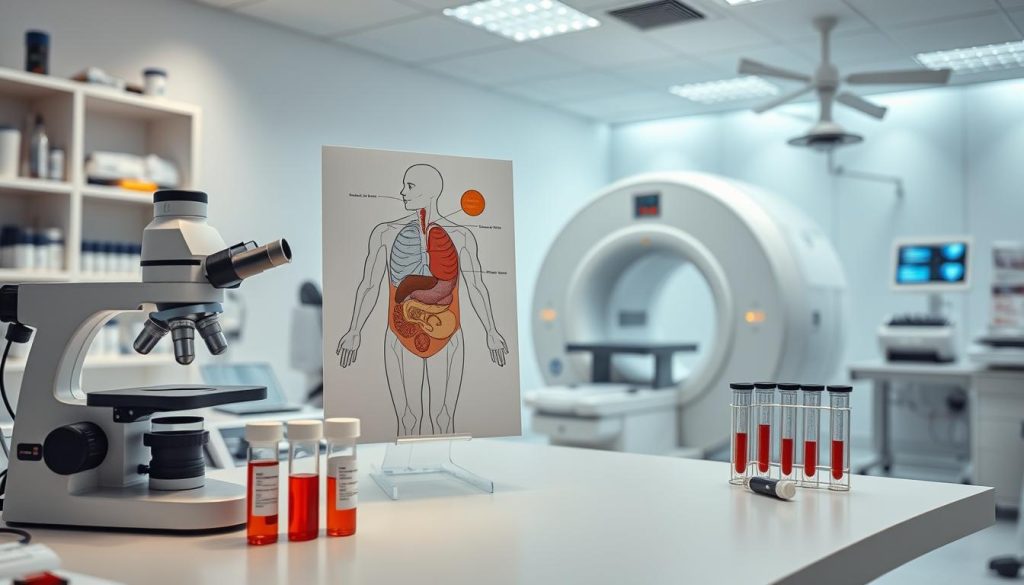
Imaging is a big help in finding cancer. X-rays, CT scans, MRIs, and PET scans show what’s inside the body. They help doctors see tumors and plan what to do next.
Biopsy is the most reliable way to diagnose cancer. It means taking a small piece of tissue for a close look. Pathologists check the cells to see if they’re cancerous. There are different ways to do a biopsy, like needle biopsies or surgical ones.
Blood tests also give clues about a person’s health and if they might have cancer. They look for proteins or substances that could mean cancer is present. Doctors often use these tests along with other methods.
| Diagnostic Method | Purpose | Invasiveness |
|---|---|---|
| Imaging Techniques | Visualize internal structures | Non-invasive |
| Biopsy | Examine tissue samples | Minimally invasive to invasive |
| Blood Tests | Detect cancer markers | Minimally invasive |
| Genetic Testing | Identify genetic mutations | Minimally invasive |
Genetic testing is getting more important in fighting cancer. It looks at a patient’s DNA to find mutations linked to cancer. This helps doctors understand the risk and plan the best treatment, which is very helpful for hereditary cancers.
Understanding Cancer Staging and Grading
Cancer staging and grading are key in planning treatment and predicting outcomes. They help doctors understand the tumor’s size and spread. This information guides the best care choices.
TNM Classification System
The TNM system is a common method for cancer staging. It looks at three main factors:
- T (Tumor): Size and spread of the primary tumor
- N (Nodes): Involvement of nearby lymph nodes
- M (Metastasis): Spread to distant parts of the body
Cancer Grade Classifications
Grading examines how cancer cells compare to normal cells under a microscope. It predicts how fast the tumor might grow and spread. Grades range from 1 to 4, with higher numbers meaning more aggressive cancer.
| Grade | Description | Cell Appearance |
|---|---|---|
| 1 | Well-differentiated | Cells look similar to normal cells |
| 2 | Moderately differentiated | Cells appear somewhat abnormal |
| 3 | Poorly differentiated | Cells look very abnormal |
| 4 | Undifferentiated | Cells are highly abnormal |
Importance of Accurate Staging
Accurate staging is very important for several reasons:
- Guides treatment selection
- Helps estimate prognosis
- Allows for better communication between healthcare providers
- Enables patients to make informed decisions about their care
Understanding staging and grading helps patients understand their diagnosis. They can then work with their healthcare team to choose the best treatment for their tumor or carcinoma.
Traditional Treatment Approaches
Cancer treatment has changed a lot over time. But, old methods are key in fighting this disease. They give hope and healing to millions of people around the world.
Surgery Options
Surgery is often the first step against solid tumors. It tries to remove cancerous tissue and sometimes lymph nodes. Surgeons use different methods, from small cuts to big operations, based on the cancer’s type and stage.
Chemotherapy Protocols
Chemotherapy uses strong drugs to kill cancer cells everywhere in the body. It’s given in cycles to let the body rest. But, it can make people lose their hair and feel sick because it affects healthy cells too.
Radiation Therapy Methods
Radiation therapy uses high-energy beams to kill cancer cells in certain areas. It can be given from outside or inside the body, depending on where the cancer is. This way, it tries to harm less of the healthy tissue around it.
| Treatment | Primary Use | Duration | Common Side Effects |
|---|---|---|---|
| Surgery | Solid tumors | Single procedure | Pain, infection risk |
| Chemotherapy | Various cancers | Weeks to months | Nausea, fatigue, hair loss |
| Radiation Therapy | Localized cancers | Daily for weeks | Skin irritation, fatigue |
These old methods are often used together to fit each patient’s needs. Your oncologist will pick the best mix of treatments for you. They consider your cancer type, stage, and health.
Innovative Cancer Treatments and Research
The field of oncology is seeing a big change in cancer treatment. New research is leading to treatments that give patients hope. These new ways of treating cancer are changing how we care for patients and making treatments better.
Precision medicine is a key part of this change. It uses a patient’s tumor genetics to choose the right treatment. This means doctors can pick treatments that work best and reduce side effects.
Immunotherapy is a big step forward in cancer treatment. It uses the body’s immune system to fight cancer. Checkpoint inhibitors, a type of immunotherapy, have shown great results in treating cancers like melanoma and lung cancer.
Liquid biopsy technology is also exciting. It’s a non-invasive way to find cancer cells or DNA in blood. This could lead to earlier diagnosis and better tracking of treatment success.
| Innovative Treatment | Description | Potential Benefits |
|---|---|---|
| CAR T-cell Therapy | Engineered immune cells target specific cancer cells | Effective against certain blood cancers |
| CRISPR Gene Editing | Modifies genes to enhance cancer-fighting abilities | Potential for precise genetic corrections |
| Nanoparticle Drug Delivery | Targets cancer cells with minimal damage to healthy tissue | Reduced side effects, improved efficacy |
As research keeps going, these new treatments promise to change cancer care. They offer patients better and less harsh options. The future of fighting cancer looks very promising, with more studies on the horizon.
Immunotherapy and Targeted Therapies
Cancer treatment has changed with the arrival of immunotherapy and targeted therapies. These new methods use the body’s immune system or target cancer cells to fight the disease.
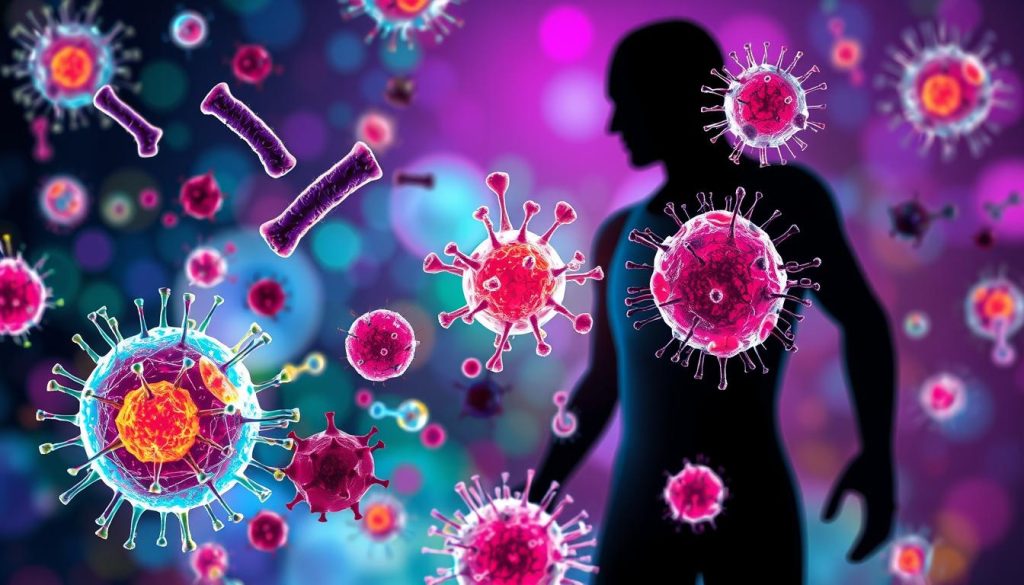
Checkpoint Inhibitors
Checkpoint inhibitors are a type of immunotherapy. They let the immune system attack cancer cells. These drugs remove the brakes that stop T-cells from fighting tumors.
This way, checkpoint inhibitors help the immune system find and kill cancer cells better.
CAR T-cell Therapy
CAR T-cell therapy is a new and exciting immunotherapy. It changes a patient’s T-cells to attack specific cancer cells. Scientists take T-cells, make them special, and put them back in the patient.
These T-cells then find and destroy cancer cells very precisely.
Monoclonal Antibodies
Monoclonal antibodies are proteins made in the lab. They target specific molecules on cancer cells. They can mark cancer cells for destruction, stop them from growing, or deliver toxic substances.
This targeted approach helps avoid harming healthy cells. It leads to fewer side effects than old treatments.
These new therapies are showing great promise in treating different cancers. They offer hope to those who don’t respond to traditional treatments. As research goes on, immunotherapy and targeted therapies are changing cancer treatment. They are leading to more effective and personalized care.
Managing Cancer Treatment Side Effects
Cancer treatments like chemotherapy and radiation therapy can be tough on patients. These therapies fight cancer but also bring unwanted side effects. It’s key to understand and manage these effects to keep quality of life during treatment.
Chemotherapy can cause nausea, fatigue, and hair loss. Radiation therapy may lead to skin irritation and tiredness. Patients might also see changes in appetite and mood swings. Spotting these symptoms early helps manage them better and improve treatment outcomes.
To tackle these issues, doctors might give medications for nausea or to boost energy. Patients can also make lifestyle changes to manage side effects:
- Eating small, frequent meals to combat nausea
- Getting adequate rest to fight fatigue
- Using gentle skincare products for radiation-induced skin issues
- Practicing relaxation techniques to manage stress and anxiety
Talking openly with your healthcare team about side effects is vital. They can tweak your treatment plan or suggest more support to enhance your comfort and well-being during this tough time.
| Treatment | Common Side Effects | Management Strategies |
|---|---|---|
| Chemotherapy | Nausea, fatigue, hair loss | Anti-nausea medication, rest, scalp cooling |
| Radiation Therapy | Skin irritation, tiredness | Gentle skincare, energy conservation |
| Both | Appetite changes, mood swings | Nutritional support, counseling |
Lifestyle Changes and Cancer Prevention
Making positive lifestyle changes is key to cancer prevention. Oncology experts stress the importance of healthy habits to lower cancer risk. Let’s look at some effective strategies for your daily life.
Dietary Recommendations
A balanced diet is vital for cancer prevention. Include lots of fruits, vegetables, and whole grains in your meals. These foods are full of antioxidants and fiber, protecting your cells.
Limit processed meats and choose lean proteins like fish and poultry. Also, cut down on alcohol, as too much drinking raises cancer risk.

Exercise Guidelines
Regular exercise is a strong tool against cancer. Aim for 150 minutes of moderate or 75 minutes of vigorous exercise weekly. Activities like brisk walking, swimming, or cycling are great.
Exercise helps keep a healthy weight and boosts your immune system. Both are key in lowering cancer risk.
Smoking Cessation
Quitting smoking is a huge step for cancer prevention. Tobacco use is linked to lung, throat, and bladder cancer. If you smoke, get help from a healthcare professional to quit.
Remember, quitting is never too late. It greatly improves your health.
By making these lifestyle changes, you can greatly reduce your cancer risk. Small steps can lead to big health improvements.
Supporting Cancer Patients: Mental and Emotional Care
Cancer affects more than just the body. It also takes a toll on patients’ and caregivers’ mental health. In oncology, it’s key to focus on mental well-being for treatment success. Cancer patients often deal with anxiety, depression, and fear, impacting their life quality and treatment results.
Holistic care is becoming more important in cancer treatment. This includes counseling, support groups, and mindfulness practices. Counseling helps patients manage their feelings and find ways to cope. Support groups offer a sense of community and shared experiences. Mindfulness, like meditation, can lower stress and improve mental focus.
Caregivers also face emotional challenges while caring for loved ones with cancer. They often feel emotionally drained and burnt out. It’s vital to have programs that offer respite care and emotional support for them. By supporting both patients and caregivers mentally, the cancer journey becomes easier.
Adding mental and emotional care to cancer treatment plans is now common. Many cancer centers provide psychosocial services along with medical treatments. This approach aims to boost survival rates and overall well-being of those dealing with cancer.
FAQ
Q: What is cancer and how does it develop?
A: Cancer is a disease where cells grow out of control. It happens when genes mutate, causing cells to divide without stopping. This leads to tumors that can spread to other parts of the body.
Q: What are the early warning signs of cancer?
A: Look out for signs like unexplained weight loss, feeling very tired, or having a fever. Also, watch for changes in skin color or texture, persistent pain, and changes in bowel or bladder habits. If you notice any of these, see a doctor right away.
Q: What are the most common types of cancer?
A: The most common cancers are breast, lung, colorectal, prostate, and skin cancer. Each has its own symptoms and treatments. Early detection through screenings is key to fighting these cancers.
Q: What are the main risk factors for developing cancer?
A: Risk factors include getting older, having a family history, and being exposed to harmful substances. Being overweight, not exercising enough, drinking too much alcohol, and viral infections also increase risk. Some risks, like genetics, can’t be changed. But, lifestyle choices can be modified to lower risk.
Q: How is cancer diagnosed?
A: Doctors use physical exams, imaging tests, blood tests, and biopsies to diagnose cancer. The tests used depend on the suspected cancer type and location. Genetic testing may also be used to help decide treatment.
Q: What is cancer staging and why is it important?
A: Staging cancer means finding out how far it has spread. It uses the TNM system to classify the tumor, lymph nodes, and metastasis. Knowing the stage helps doctors choose the best treatment and predict outcomes.
Q: What are the main treatment options for cancer?
A: Treatments include surgery, chemotherapy, and radiation therapy. These can be used alone or together, based on the cancer type and stage. New treatments like immunotherapy and targeted therapies are also being used.
Q: What is immunotherapy and how does it work?
A: Immunotherapy boosts the body’s immune system to fight cancer. It can stimulate the immune system or give it tools to fight cancer. Examples include checkpoint inhibitors and CAR T-cell therapy.
Q: How can I manage the side effects of cancer treatment?
A: Managing side effects involves medication, lifestyle changes, and supportive care. This includes anti-nausea drugs, pain management, proper nutrition, and exercise. It’s important to talk to your doctor about any side effects you have.
Q: Can lifestyle changes help prevent cancer?
A: Yes, making healthy lifestyle choices can lower cancer risk. Eat a healthy diet, exercise regularly, avoid tobacco, and limit alcohol. Protect your skin from the sun and get vaccinated against viruses like HPV. Regular screenings are also important for early detection.













